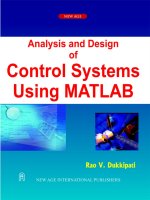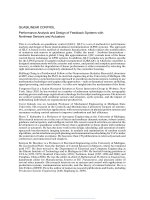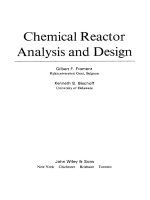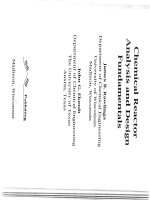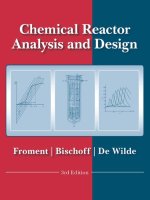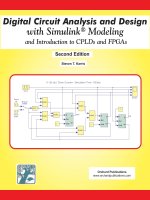chemical reactor analysis and design
Bạn đang xem bản rút gọn của tài liệu. Xem và tải ngay bản đầy đủ của tài liệu tại đây (11.89 MB, 902 trang )
This page intentionally left blank
Chemical Reactor
Analysis and Design
3rd Edition
Gilbert F. Froment
Texas A&M University
Kenneth B. Bischoff
†
University of Delaware
Juray De Wilde
Université Catholique de Louvain, Belgium
John Wiley & Sons, Inc.
ACQUISITIONS EDITOR Jennifer Welter
MARKETING MANAGER Christopher Ruel
EDITORIAL ASSISTANT Alexandra Spicehandler
SENIOR DESIGNER Kevin Murphy
EXECUTIVE MEDIA EDITOR Thomas Kulesa
PRODUCTION MANAGER Micheline Frederick
PRODUCTION EDITOR Amy Weintraub
This book was printed and bound by Hamilton Printing Company. The cover was printed by Phoenix
Color.
This book is printed on acid free paper. ∞
Copyright © 2011 John Wiley & Sons, Inc. All rights reserved. No part of this publication may be
reproduced, stored in a retrieval system or transmitted in any form or by any means, electronic,
mechanical, photocopying, recording, scanning or otherwise, except as permitted under Sections 107 or
108 of the 1976 United States Copyright Act, without either the prior written permission of the
Publisher, or authorization through payment of the appropriate per-copy fee to the Copyright Clearance
Center, Inc. 222 Rosewood Drive, Danvers, MA 01923, website www.copyright.com. Requests to the
Publisher for permission should be addressed to the Permissions Department, John Wiley & Sons, Inc.,
111 River Street, Hoboken, NJ 07030-5774, (201)748-6011, fax (201)748-6008, website
“Evaluation copies are provided to qualified academics and professionals for review purposes only, for
use in their courses during the next academic year. These copies are licensed and may not be sold or
transferred to a third party. Upon completion of the review period, please return the evaluation copy to
Wiley. Return instructions and a free of charge return shipping label are available at
www.wiley.com/go/returnlabel. Outside of the United States, please contact your local representative.”
Library of Congress Cataloging-in-Publication Data
Froment, Gilbert F.
Chemical reactor analysis and design. 3rd ed. / Gilbert Froment, Juray DeWilde, and Kenneth
Bischoff.
p. cm.
Includes bibliographical references and index.
ISBN 978-0-470-56541-4 (cloth)
1. Chemical reactors. 2. Chemical reactions. 3. Chemical engineering. I. DeWilde, Juray. II. Bischoff,
Kenneth B. III. Title.
TP157.F76 2011
660'.2832 dc22
2010014481
Printed in the United States of America
10 9 8 7 6 5 4 3 2 1
From Gilbert to Mia.
From Juray, to my brother Tibor, to Junior and Mathieu.
Chemical Reactor Analysis and Design
Gilbert F. Froment, Texas A&M University; K.B. Bischoff
†
, University of
Delaware; Juray De Wilde, Université Catholique de Louvain.
This is the Third Edition of Chemical Reactor Analysis and Design. The first
was published by Wiley in 1979 and the second, after a substantial revision, in
1990. When we undertook the third edition in 2008, eighteen years had elapsed
since the second edition. This is a significant period of time during which
chemical reaction engineering has considerably evolved. The tremendous growth
of computer power and the easy access to it has significantly contributed to a
more comprehensive description of phenomena, operations and equipment, thus
enabling the development and application of more fundamental and presumably
more accurate models. Modern chemical reaction engineering courses should
reflect this evolution towards a more scientific approach. We have been
permanently aware of these trends during the elaboration of the present edition
and have largely rewritten the complete text. The more fundamental approach
has not distracted us, however, from the emphasis on the real world of chemical
reaction engineering, one of the main objectives and strengths of the first edition
already, widely recognized all over the world.
We have maintained the structure of the previous editions, dividing the
content into two parts. The first part deals with the kinetics of phenomena that
are important in reaction engineering: reaction kinetics, both “homogeneous” —
in a single phase — and “heterogeneous,” involving a gas- and a liquid- or solid
phase. The mechanism of the reactions has been accounted for in greater detail
than previously, in an effort to be more realistic, but also more reliable in their
kinetic modeling e.g., in thermal cracking, polymerization, hydrocarbon
processing and bio-processes. The field of reaction kinetics has substantially
progressed by the growing availability through commercial software of quantum
chemical methods. Students of chemical reaction engineering can no longer
ignore their potential and they should be taught how to apply them meaningfully
to real processes. Chapters 1, 2 and 3 attempt to do that. In the heterogeneous
reaction case, heat and mass transfer phenomena at the interface and inside the
reaction phase have to be considered. In modeling these the internal structure of
the catalyst has been given more emphasis, starting from insight provided from
well developed characterization tools and using advanced techniques like Monte
Carlo simulation, Percolation theory and Effective Medium Approximation. This
approach is further applied in Chapter 4 on gas-solid reactions and Chapter 5 on
catalyst deactivation. The insertion of more realistic kinetics into structure
models of the catalyst has also allowed accounting for the role of catalyst
deactivation by coke formation in important commercial hydrocarbon conversion
processes, like butene dehydrogenation, steam reforming of natural gas and the
catalytic cracking of vacuum gas oil. Chapter 6 on gas-liquid kinetics has
retained its previous structure.
Part II addresses the chemical reactor itself, inserting the kinetic aspects
of Part I into the modeling and simulation of the reactor operation. Chapter 7
introduces the fundamental mass-, energy- and momentum balances. The
Chapters 8, 9, 10 and 11, dealing with the basic types, like the batch, semi-batch,
continuous flow reactor with complete mixing and the tubular reactor, filled or
not with solid catalyst, have been maintained, of course, and also their strong ties
to industrial processes. Deviations of what was previously called “ideal “ models
and behavior are dealt with along entirely new lines, made possible by the
progress of CFD — computational fluid dynamics — also made available by
commercial software. This approach is introduced already in Chapter 11 on fixed
bed reactors and consistently applied in Chapter 12, leading to a unified and
structured approach of flow, residence time and conversion in the variety of
reactors encountered in industrial practice. This is another field that has not yet
received sufficient attention in chemical engineering curricula. Substantial
progress and a growing number of applications can be expected in the coming
years. It is illustrated also in Chapter 13 on fluidized- and transport bed reactors,
that enters into greater details than before on the catalytic cracking of heavy oil
fractions and reports on simulations based upon computational fluid dynamics.
A book like this has to show the path and prepare the future. We should not look
down, however, upon the correlations derived from experimentation and
collected by the profession over the years, be they limited in their range of
application. There is no way that these could be refined or completely replaced
yet by CFD application only. Unfortunately, the computational effort involved in
the use of CFD in combination with reaction and transport phenomena
throughout the entire reactor is overwhelming and its routine-like application to
real, practical cases not for the immediate future. Chapter 14 on multiphase
reactors is evidence for this and illustrates sound and proved engineering
practice.
Finally, we want to remember Ken Bischoff, who deceased in July 2007
and could not participate in this third edition.
Gilbert F. Froment Juray De Wilde
Texas A & M University Université Catholique de Louvain
December 2009
About the Authors
G.F. Froment
Gilbert F. Froment received his Ph.D. in Chemical Engineering from the
University of Gent, Belgium, in 1957. He did post-doctoral work at the
University of Darmstadt in Germany and the University of Wisconsin. In 1968 he
became a full professor of Chemical Engineering in Gent and launched the
“Laboratorium voor Petrochemische Techniek” that became world famous. His
scientific work centered on fixed bed reactor modeling, kinetic modeling,
catalyst deactivation and thermal cracking for olefins production. In 1998 he
joined the Chemical Engineering Department of Texas A & M University as a
Research Professor. He has directed the work of 68 Ph.D students and published
350 scientific papers in international journals. He presented more than 320
seminars in universities and at international symposia all over the world. The
book Chemical Reactor Analysis and Design (with K.B. Bischoff) is used
worldwide in graduate courses and industrial research groups and was translated
into Chinese. He has been on the editorial board of the major chemical
engineering journals. In his present position, at Texas A & M University, Dr.
Froment directs the research of a group of Ph.D students and post-docs on
Chemical Reaction Engineering aspects of Hydrocarbon Processing in the
Petroleum and Petrochemical Industry, more particularly on the kinetic modeling
of complex processes like hydrocracking and hydrotreatment, catalytic cracking,
catalytic reforming, methanol-to-olefins, solid acid alkylation, thermal cracking,
using single event kinetics, a concept that he launched in the eighties. He
received the prestigious R.H. Wilhelm Award for Chemical Reaction
Engineering from the A.I.Ch.E. in 1978, the first Villermaux-Medal from the
European Federation of Chemical Engineering in 1999 and the 3-yearly
Amundson Award of ISCRE in 2007.
G.F. Froment is a Doctor Honoris Causa of the Technion, Haifa, Israel
(1985), of the University of Nancy, France (2001) and an Honorary Professor of
the Universidad Nacional de Salta (Argentina). He is a member of the Belgian
Academy of Science (1984), the Belgian Academy of Overseas Science (1977), a
Foreign Associate of the United States National Academy of Engineering (1999)
and a member of the Texas Academy of Medicine, Science and Engineering
(2003). He was a member of the Scientific Council of the French Petroleum
Institute (1989-1997), of the Technological Council of Rhône-Poulenc (1988-
1997) and has intensively consulted for the world’s major petroleum and
(petro)chemical companies.
K.B. Bischoff †
Kenneth B. Bischoff was the Unidel Professor of Biomedical and Chemical
Engineering and past Chairman, Department of Chemical Engineering at the
University of Delaware. Previously he was Acting Director for the Center for
Catalytic Science and Technology. He was the Walter R. Read Professor of
Engineering and Director of the School of Chemical Engineering at Cornell
University and had been on the faculties of the Universities of Maryland and
Texas (Austin), as well as a Postdoctoral Fellow at the University of Gent,
Belgium. He had served as a consultant for Exxon Research and Engineering
Company, General Foods Company, the National Institutes of Health, W. R.
Grace company, Koppers Company, E. I. du Pont de Nemours
&
Co., Inc.,
and Westvaco Co., and was a registered professional engineer in the State of
Texas. His research interests were in the areas of chemical reaction
engineering and applications to pharmacology and toxicology, resulting in
more than 100 journal articles and two textbooks:
Process Analysis and
Simulation
(with D.M. Himmelblau) (1968); and
Chemical Reactor Analysis and
Design
,
(with G.F. Froment) (1979). He was elected to the National Academy
of Engineering in 1988, and he received the 1972 Ebert Prize of the
Academy of Pharmaceutical Sciences, the 1976 Professional Progress
Award, the 1982 Institute Lecture Award, the 1982 Food, Pharmaceutical
and Bioengineering Division Award, and the 1987 R. H.
Wilhelm Award. In
1987 he
was named a Fellow of the American Institute of Chemical
Engineers. He was a Fellow of AAAS
since 1980.
Editorial boards on which
he had served include
J.
Pharmacokinetics and Biopharmaceutics, from 1972
on; and
ACS Advances in Chemistry Series, 1974
to
1981.
In
1981
he became
an Associate Editor of
Advances in Chemical Engineering,
Dr. Bischoff passed away in 2007.
J. De Wilde
Juray De Wilde received his Ph.D in Chemical Engineering from the Ghent
University, Belgium, in 2001. He did post-doctoral work at the Ghent University
and was post-doc research associate at the Chemical Engineering Department of
Princeton University, NJ. In 2005 he became professor of Chemical Engineering
at the Université catholique de Louvain, Belgium, where he received his tenure
in 2008. Dr. De Wilde published more than 30 papers in international journals
and served as a member of scientific committees and as a consultant for
numerous companies, including Total Petrochemicals, Tribute Creations, Dow
Corning, PVS Chemicals, The Catalyst Group, Nanotech-Nanopole, Certech,
etc His research interests and expertise include dynamic methods for catalytic
kinetics, the modeling and simulation of gas-solid flows, and process
intensification, in particular for fluidized bed processes. With A. de Broqueville,
he developed the rotating fluidized bed in a static geometry and the rotating
chimney technologies.
Contents — Chemical Reactor Analysis and Design,
Third edition
G.F. Froment, K.B. Bischoff, J. De Wilde
Chapter 1: Elements of Reaction Kinetics
1.1 Definitions of Chemical Rates 2
1.1.1 Rates of Disappearance of Reactants and of Formation 2
of Products
1.1.2 The Rate of a Reaction 3
1.2 Rate Equations 5
1.2.1 General Structure 5
1.2.2 Influence of Temperature 7
Example 1.2.2.A Determination of the Activation 8
Energy
1.2.3 Typical Rate Equations for Simple Reactions 9
1.2.3.1 Reversible First-Order Reactions 9
1.2.3.2 Second-Order Reversible Reactions 10
1.2.3.3 Autocatalytic Reactions 11
1.2.4 Kinetic Analysis 13
1.2.4.1 The Differential Method of Kinetic Analysis 13
1.2.4.2 The Integral Method of Kinetic Analysis 14
1.3 Coupled Reactions 17
1.3.1 Parallel Reactions 17
1.3.2 Consecutive Reactions 19
1.3.3 Mixed Parallel-Consecutive Reactions 21
1.4 Reducing the Size of Kinetic Models 21
1.4.1 Steady State Approximation 21
1.4.2 Rate Determining Step of a Sequence of Reactions 22
1.5 Bio-Kinetics 23
1.5.1 Enzymatic Kinetics 23
1.5.2 Microbial Kinetics 26
1.6 Complex Reactions 30
1.6.1 Radical Reactions for the Thermal Cracking 30
for Olefins Production
Example 1.6.1.A Activation Energy of a Complex 32
Reaction
1.6.2 Free Radical Polymerization Kinetics 38
1.7 Modeling the Rate Coefficient 43
1.7.1 Transition State Theory 43
1.7.2 Quantum Mechanics. The Schrödinger Equation 48
1.7.3 Density Functional Theory 49
Chapter 2: Kinetics of Heterogeneous Catalytic Reactions
2.1 Introduction 61
2.2 Adsorption on Solid Catalysts 67
2.3 Rate Equations 71
2.3.1 Single Reactions 72
Example 2.3.1.A Competitive Hydrogenation Reactions 76
2.3.2 Coupled Reactions 81
2.3.3 Some Further Thoughts on the Hougen-Watson Rate 86
Equations
2.4 Complex Catalytic Reactions 87
2.4.1 The Kinetic Modeling of Commercial Catalytic Processes 87
2.4.2 Generation of the Network of Elementary Steps 89
2.4.3 Modeling of the Rate Parameters 92
2.4.3.1 The Single Event Concept 92
2.4.3.2 The Evans-Polanyi Relationship for the 94
Activation Energy
2.4.4 Application to Hydrocracking 96
2.5 Experimental Reactors 99
2.6 Model Discrimination and Parameter Estimation 104
2.6.1 The Differential Method of Kinetic Analysis 104
2.6.2 The Integral Method of Kinetic Analysis 110
2.6.3 Parameter Estimation and Statistical Testing of Models 112
and Parameters in Single Reactions
2.6.3.1 Models That Are Linear in the Parameters 112
2.6.3.2 Models That Are Nonlinear in the Parameters 117
2.6.4 Parameter Estimation and Statistical Testing of Models 119
and Parameters in Multiple Reactions
Example 2.6.4.A Benzothiophene Hydrogenolysis 123
2.6.5 Physicochemical Tests on the Parameters 126
2.7 Sequential Design of Experiments 126
2.7.1 Sequential Design for Optimal Discrimination between 127
Rival Models
2.7.1.1 Single Response Case 127
Example 2.7.1.1.A Model Discrimination in the 130
Dehydrogenation of 1-Butene into
Butadiene
Example 2.7.1.1.B Ethanol Dehydrogenation: 133
Sequential Discrimination using
the Integral Method of Kinetic
Analysis
2.7.1.2 Multiresponse Case 137
2.7.2 Sequential Design for Optimal Parameter Estimation 138
2.7.2.1 Single Response Models 138
2.7.2.2 Multiresponse Models 139
Example 2.7.2.2.A Sequential Design for Optimal 139
Parameter Estimation in Benzo-
thiophene Hydrogenolysis
2.8 Expert Systems in Kinetics Studies 142
Chapter 3: Transport Processes with Reactions Catalyzed
by Solids
PART ONE INTERFACIAL GRADIENT EFFECTS
3.1 Reaction of a Component of a Fluid at the Surface of a Solid 154
3.2 Mass and Heat Transfer Resistances 156
3.2.1 Mass Transfer Coefficients 156
3.2.2 Heat Transfer Coefficients 158
3.2.3 Multicomponent Diffusion in a Fluid 160
Example 3.2.3.A Use of a Mean Binary Diffusivity 162
3.3 Concentration or Partial Pressure and Temperature Differences 163
Between Bulk Fluid and Surface of a Catalyst Particle
Example 3.3.A Interfacial Gradients in Ethanol 165
Dehydrogenation Experiments
PART TWO INTRAPARTICLE GRADIENT EFFECTS
3.4 Molecular, Knudsen, and Surface Diffusion in Pores 172
3.5 Diffusion in a Catalyst Particle 176
3.5.1 A Pseudo-Continuum Model 176
3.5.1.1 Effective Diffusivities 176
3.5.1.2 Experimental Determination of Effective 177
Diffusivities of a Component and of the
Tortuosity
Example 3.5.1.2.A Experimental 178
Determination of the
Effective Diffusivity of
a Component and of the
Catalyst Tortuosity by
Means of the Packed
Column Technique
Example 3.5.1.2.B Application of the Pellet 180
Technique
3.5.2 Structure Models 180
3.5.2.1 The Random Pore Model 181
3.5.2.2 The Parallel Cross-Linked Pore Model 182
3.5.3 Network Models 184
3.5.3.1 A Bethe Tree Model 184
3.5.3.2 Disordered Pore Media 188
Example 3.5.A Optimization of Catalyst Pore Structure 189
3.5.4 Diffusion in Zeolites. Configurational Diffusion 190
3.5.4.1 Molecular Dynamics Simulation 191
3.5.4.2 Dynamic Monte-Carlo Simulation 193
3.6 Diffusion and Reaction in a Catalyst Particle. A Continuum 193
Model
3.6.1 First-Order Reactions. The Concept of Effectiveness 193
Factor
3.6.2 More General Rate Equations. The Generalized Modulus 197
Example 3.6.2.A Application of Generalized Modulus 200
for Simple Rate Equations
3.6.3 Multiple Reactions 201
3.7 Falsification of Rate Coefficients and Activation Energies by 204
Diffusion Limitations
Example 3.7.A Effectiveness Factors for Sucrose Inversion 206
in Ion Exchange Resins
3.8 Influence of Diffusion Limitations on the Selectivities of 207
Coupled Reactions
3.9 Criteria for the Importance of Intraparticle Diffusion 213
Limitations
Example 3.9.A Application of the Extended Weisz-Prater 217
Criterion
3.10 Multiplicity of Steady States in Catalyst Particles 218
3.11 Combination of External and Internal Diffusion Limitations 219
3.12 Diagnostic Experimental Criteria for the Absence of Internal 221
and External Mass Transfer Limitations
3.13 Nonisothermal Particles 223
3.13.1 Thermal Gradients Inside Catalyst Particles 223
3.13.2 External and Internal Temperature Gradients 225
Example 3.13.2.A Temperature Gradients Inside the 228
Catalyst Particles in Benzene
Hydrogenation
Chapter 4: Noncatalytic Gas-Solid Reactions
4.1 A Qualitative Discussion of Gas-Solid Reactions 240
4.2 General Model with Interfacial and Intraparticle Gradients 243
4.3 Heterogeneous Model with Shrinking Unreacted Core 252
Example 4.3.A Combustion of Coke within Porous Catalyst 255
Particles
4.4 Models Accounting Explicitly for the Structure of the Solid 259
4.5 On the Use of More Complex Kinetic Equations 264
Chapter 5: Catalyst Deactivation
5.1 Types of Catalyst Deactivation 270
5.1.1 Solid-State Transformations 270
5.1.2 Poisoning 271
5.1.3 Coking 271
5.2 Kinetics of Catalyst Poisoning 271
5.2.1 Introduction 271
5.2.2 Kinetics of Uniform Poisoning 273
5.2.3 Shell-Progressive Poisoning 275
5.2.4 Effect of Shell-Progressive Poisoning on the 280
Selectivity of Simultaneous Reactions
5.3 Kinetics of Catalyst Deactivation by Coke Formation 285
5.3.1 Introduction 285
5.3.2 Kinetics of Coke Formation 288
5.3.2.1 Deactivation Functions 288
5.3.2.2 Catalyst Deactivation by Site Coverage Only 288
5.3.2.3 Catalyst Deactivation by Site Coverage and 294
Pore Blockage
5.3.2.4 Deactivation by Site Coverage and Pore 296
Blockage in the Presence of Diffusion
Limitations
5.3.2.5 Deactivation by Site Coverage, Growth of 298
Coke, and Blockage in Networks of Pores
5.3.3 Kinetic Analysis of Deactivation by Coke Formation 299
Example 5.3.3.A Application to Industrial Processes: 303
Coke Formation in the Dehydro-
genation of 1-Butene into Butadiene
Example 5.3.3.B Application to Industrial Processes: 309
Rigorous Kinetic Equations for
Catalyst Deactivation by Coke
Deposition in the Dehydrogenation
of 1-Butene into Butadiene
Example 5.3.3.C Application to Industrial Processes: 312
Coke Formation and Catalyst
Deactivation in Steam Reforming
of Natural Gas
Example 5.3.3.D Application to Industrial Processes: 316
Coke Formation in the Catalytic
Cracking of Vacuum Gas Oil
5.3.4 Conclusions 318
Chapter 6: Gas-Liquid Reactions
6.1 Introduction 322
6.2 Models for Transfer at a Gas-Liquid Interface 323
6.3 Two-Film Theory 326
6.3.1 Single Irreversible Reaction with General Kinetics 326
6.3.2 First-Order and Pseudo-First-Order Irreversible 328
Reactions
6.3.3 Single, Instantaneous, and Irreversible Reactions 332
6.3.4 Some Remarks on Boundary Conditions and on 337
Utilization and Enhancement Factors
6.3.5 Extension to Reactions with Higher Orders 340
6.3.6 Coupled Reactions 342
6.4 Surface Renewal Theory 346
6.4.1 Single Instantaneous Reactions 347
6.4.2 Single Irreversible (Pseudo)-First-Order Reactions 351
6.4.3 Surface Renewal Models with Surface Elements of 355
Limited Thickness
6.5 Experimental Determination of the Kinetics of Gas-Liquid 356
Reactions
6.5.1 Introduction 356
6.5.2 Determination of k
L
and A
V
357
6.5.3 Determination of k
G
and A
V
358
6.5.4 Specific Equipment 359
Chapter 7: The Modeling of Chemical Reactors
7.1 Approach 366
7.2 Aspects of Mass, Heat and Momentum Balances 367
7.3 The Fundamental Model Equations 369
7.3.1 The Species Continuity Equations 369
7.3.1.1 A General Formulation 369
7.3.1.2 Specific Forms 373
7.3.2 The Energy Equation 377
7.3.2.1 A General Formulation 377
7.3.2.2 Specific Forms 378
7.3.3 The Momentum Equations 380
Chapter 8: The Batch and Semibatch Reactors
Introduction 384
8.1 The Isothermal Batch Reactor 385
Example 8.1.A Example of Derivation of a Kinetic Equation 388
from Batch Data
Example 8.1.B Styrene Polymerization in a Batch Reactor 390
Example 8.1.C Production of Gluconic Acid by Aerobic 394
Fermentation of Glucose
8.2 The Nonisothermal Batch Reactor 396
Example 8.2.A Decomposition of Acetylated Castor Oil Ester 399
8.3 Semibatch Reactor Modeling 402
Example 8.3.A Simulation of Semibatch Reactor Operation 403
(with L.H. Hosten
†
)
8.4 Optimal Operation Policies and Control Strategies 407
8.4.1 Optimal Batch Operation Time 407
Example 8.4.1.A Optimum Conversion and Maximum 410
Profit for a First-Order Reaction
8.4.2 Optimal Temperature Policies 411
Example 8.4.2.A Optimal Temperature Trajectories 412
for First-Order Reversible Reactions
Example 8.4.2.B Optimum Temperature Policies for 418
Consecutive and Parallel Reactions
Chapter 9: The Plug Flow Reactor
9.1 The Continuity, Energy, and Momentum Equations 427
9.2 Kinetic Studies Using a Tubular Reactor with Plug Flow 432
9.2.1 Kinetic Analysis of Isothermal Data 432
9.2.2 Kinetic Analysis of Nonisothermal Data 435
9.3 Design and Simulation of Tubular Reactors with Plug Flow 438
9.3.1 Adiabatic Reactor with Plug Flow 439
9.3.2 Design and Simulation of Non-Isothermal Cracking 441
Tubes for Olefins Production
Chapter 10: The Perfectly Mixed Flow Reactor
10.1 Introduction 453
10.2 Mass and Energy Balances 454
10.2.1 Basic Equations 454
10.2.2 Steady-State Reactor Design 455
10.3 Design for Optimum Selectivity in Simultaneous Reactions 461
10.3.1 General Considerations 461
10.3.2 Polymerization in Perfectly Mixed Flow Reactors 468
10.4 Stability of Operation and Transient Behavior 471
10.4.1 Stability of Operation 471
10.4.2 Transient Behavior 478
Example 10.4.2.A Temperature Oscillations in a Mixed 481
Reactor for the Vapor-Phase Chlorination
of Methyl Chloride
Chapter 11: Fixed Bed Catalytic Reactors
P
ART ONE INTRODUCTION
11.1 The Importance and Scale of Fixed Bed Catalytic Processes 493
11.2 Factors of Progress: Technological Innovations and Increased 494
Fundamental Insight
11.3 Factors Involved in the Preliminary Design of Fixed Bed 495
Reactors
11.4 Modeling of Fixed Bed Reactors 503
P
ART TWO PSEUDOHOMOGENEOUS MODELS
11.5 The Basic One-Dimensional Model 505
11.5.1 Model Equations 505
Example 11.5.1.A Calculation of Pressure Drop in 510
Packed Beds
11.5.2 Design of a Fixed Bed Reactor According to the One- 510
Dimensional Pseudohomogeneous Model
11.5.3 Runaway Criteria 513
Example 11.5.3.A Application of the First Runaway 519
Criterion of Van Welsenaere and
Froment
11.5.4 The Multibed Adiabatic Reactor 522
11.5.5 Fixed Bed Reactors with Heat Exchange Between the 530
Feed and Effluent or Between the Feed and Reacting
Gas. “Autothermal Operation”
11.5.6 Nonsteady-State Behavior of Fixed Bed Catalytic 548
Reactors Due to Catalyst Deactivation
11.6 One-Dimensional Model with Axial Mixing 559
11.7 Two-Dimensional Pseudohomogeneous Models 565
11.7.1 The Effective Transport Concept 565
11.7.2 Continuity and Energy Equations 571
11.7.3 Design or Simulation of a Fixed Bed Reactor for 572
Catalytic Hydrocarbon Oxidation
11.7.4 An Equivalent One-Dimensional Model 578
11.7.5 A Two-Dimensional Model Accounting for Radial 579
Variations in the Bed Structure
11.7.6 Two-Dimensional Cell Models 583
P
ART THREE HETEROGENEOUS MODELS
11.8 One-Dimensional Model Accounting for Interfacial Gradients 585
11.8.1 Model Equations 585
11.8.2 Simulation of the Transient Behavior of a Reactor 589
Example 11.8.2.A A Gas-Solid Reaction in a Fixed Bed 591
Reactor
11.9 One-Dimensional Model Accounting for Interfacial and 597
Intraparticle Gradients
11.9.1 Model Equations 597
Example 11.9.1.A Simulation of a Primary Steam 604
Reformer
Example 11.9.1.B Simulation of an Industrial Reactor 614
for 1-Butene Dehydrogenation into
Butadiene
Example 11.9.1.C Influence of Internal Diffusion 621
Limitations in Catalytic Reforming
11.10 Two-Dimensional Heterogeneous Models 623
Chapter 12: Complex Flow Patterns
12.1 Introduction 639
12.2 Macro- and Micro-Mixing in Reactors 640
12.3 Models Explicitly Accounting for Mixing 643
12.4 Micro-Probability Density Function Methods 649
12.4.1 Micro-PDF Transport Equations 649
12.4.2 Micro-PDF Methods for Turbulent Flow and Reactions 653
12.5 Micro-PDF Moment Methods: Computational Fluid Dynamics 658
12.5.1 Turbulent Momentum Transport. Modeling of the 662
Reynolds-Stresses
Annex 12.5.1.A Reynolds-Stress Transport Equations (web)
12.5.2 Turbulent Transport of Species and Heat. Modeling of 666
the Scalar Flux
Annex 12.5.2.A Scalar Flux Transport Equations (web)
12.5.3 Macro-Scale Averaged Reaction Rates 667
Annex 12.5.3.A Moment Methods: Transport Equa- (web)
tions for the Species Concentration
Correlations
12.5.3.1 Models Based upon the Concept of Eddy 668
Dissipation
12.5.3.2 The Eddy Break-Up Model 669
Example 12.5.A Three Dimensional CFD Simulation of 670
Furnace and Reactor Tubes for the Thermal
Cracking of Hydrocarbons
12.6 Macro-PDF / Residence Time Distribution Methods 677
12.6.1 Reactor Scale Balance and Species Continuity 677
Equations
Example 12.6.1.A Population Balance Model for 678
Micro-Mixing in a Perfectly
Macro-Mixed Reactor: PDF
Moment Method
12.6.2 Age Distribution Functions 685
Example 12.6.2.A RTD of a Perfectly Mixed Vessel 688
Example 12.6.2.B Experimental Determination of 689
the RTD
12.6.3 Flow Patterns Derived from the RTD 691
Example 12.6.3.A RTD for Series of N Completely 693
Stirred Tanks
12.6.4 Application of RTD to Reactors 694
Example 12.6.4.A First Order Reaction(s) in 696
Isothermal Completely Mixed
Reactors, Plug Flow Reactors,
and Series of Completely Stirred
Tanks
Example 12.6.4.B Second Order Bimolecular 698
Reaction in Isothermal Completely
Mixed Reactors and in a Succession
of Isothermal Plug Flow and
Completely Mixed Reactors:
Completely Macro-Mixed versus
Completely Macro- and Micro-
Mixed
12.7 Semi-Empirical Models for Reactors with Complex Flow 699
Patterns
12.7.1 Multi-Zone Models 699
12.7.2 Axial Dispersion and Tanks-in-Series Models 703
Chapter 13: Fluidized Bed and Transport Reactors
13.1 Introduction 719
13.2 Technological Aspects of Fluidized Bed and Riser Reactors 720
13.2.1 Fluidized Bed Catalytic Cracking 720
13.2.2 Riser Catalytic Cracking 723
13.3 Some Features of the Fluidization and Transport of Solids 723
13.4 Heat Transfer in Fluidized Beds 729
13.5 Modeling of Fluidized Bed Reactors 731
13.5.1 Two-Phase Model 731
13.5.2 Bubble Velocity, Size and Growth 735
13.5.3 A Hydrodynamic Interpretation of the Interchange 736
Coefficient k
I
13.5.4 One-Phase Model 742
13.6 Modeling of a Transport or Riser Reactor 743
13.7 Fluidized Bed Reactor Models Considering Detailed Flow 744
Patterns
13.8 Catalytic Cracking of Vacuum Gas Oil 749
13.8.1 Kinetic Models for the Catalytic Cracking of Vacuum 749
Gas Oil
13.8.2 Simulation of the Catalytic Cracking of Vacuum Gas 753
Oil
13.8.2.1 Fluidized Bed Reactor. Two-Phase Model 753
with Ten Lump Reaction Scheme
13.8.2.2 Fluidized Bed Reactor. Reynolds-Averaged 756
Navier-Stokes Model with Ten Lump
Reaction Scheme
13.8.2.3 Riser Reactor. Plug Flow Model with Slip 758
with Reaction Scheme based upon
Elementary Steps. Single Event Kinetics
13.8.3 Kinetic Models for the Regeneration of a Coked 762
Cracking Catalyst
13.8.4 Simulation of the Regenerator of a Catalytic Cracking 763
Unit
13.8.5 Coupled Simulation of a Fluidized Bed (or Riser) 765
Catalytic Cracker and Regenerator
Chapter 14: Multiphase Flow Reactors
14.1 Types of Multiphase Flow Reactors 780
14.1.1 Packed Columns 780
14.1.2 Plate Columns 782
14.1.3 Empty Columns 782
14.1.4 Stirred Vessel Reactors 783
14.1.5 Miscellaneous Reactors 783
14.2 Design Models for Multiphase Flow Reactors 784
14.2.1 Gas and Liquid Phases Completely Mixed 784
14.2.2 Gas and Liquid Phase in Plug Flow 785
14.2.3 Gas Phase in Plug Flow. Liquid Phase Completely 786
Mixed
14.2.4 An Effective Diffusion Model 786
14.2.5 A Two-Zone Model 788
14.2.6 Models Considering Detailed Flow Patterns 788
14.3 Specific Design Aspects 789
14.3.1 Packed Absorbers 789
Example 14.3.1.A The Simulation or Design of a 793
Packed Bed Absorption Tower
Example 14.3.1.B The Absorption of CO
2
into a 797
Monoethanolamine (MEA) Solution
14.3.2 Two-Phase Fixed Bed Catalytic Reactors with 801
Cocurrent Downflow. “Trickle” Bed Reactors and
Packed Downflow Bubble Reactors
Example 14.3.2.A Trickle Bed Hydrocracking of 810
Vacuum Gas Oil
14.3.3 Two-Phase Fixed Bed Catalytic Reactors with 813
Cocurrent Upflow. Upflow Packed Bubble Reactors
14.3.4 Plate Columns 815
Example 14.3.4.A The Simulation or Design of a 818
Plate Column for Absorption and
Reaction
Example 14.3.4.B The Absorption of CO
2
in an 822
Aqueous Solution of Mono- and
Diethanolamine (MEA and DEA)
14.3.5 Spray Towers 827
14.3.6 Bubble Reactors 827
Example 14.3.6.A Simulation of a Bubble Column 830
Reactor Considering Detailed Flow
Patterns and a First-Order
Irreversible Reaction. Comparison
with Conventional Design Models
14.3.7 Stirred Vessel Reactors 832
Example 14.3.7.A Design of a Liquid-Phase 837
o-Xylene Oxidation Reactor
This page intentionally left blank
i
Notation
Great attention has been given to the detailed definition of the units of the
different quantities: for example, when a dimension of length is used, it is always
clarified as to whether this length concerns the catalyst or the reactor. We have
found that this greatly promotes insight into the mathematical modeling of a
phenomenon and avoids errors.
A
reaction component
b
A
heat exchange surface, packed bed side m²
j
A reacting species
k
A
heat exchange surface in a batch reactor, m²
on the side of the reaction mixture
m
A
logarithmic mean of A
k
and A
r
or of A
b
and A
r
m²
r
A
heat exchange surface for a batch reactor, m²
on the side of the heat transfer medium
t
A
total heat exchange surface m²
v
A
gas-liquid interfacial area per unit liquid volume
3
L
2
i
/mm
o
A frequency factor, for 1
st
order, e.g. s
-1
'
v
A
gas-liquid interfacial area per unit gas +
liquid volume
3
GL
2
i
/mm
A
~
single event frequency factor s
-1
a stoichiometric coefficient
g
a surface to volume ratio of a particle
3
p
2
p
/mm
m
a external particle surface area per unit catalyst mass cat./kgm
2
p
v
a external particle surface area per unit reactor volume
3
r
2
p
/mm
'
,'
j
aa order of reaction with respect to A, A
j
'
v
a gas-liquid interfacial area per unit packed volume
3
r
2
i
/mm
"
v
a
liquid-solid interfacial area per unit packed volume
3
r
2
i
/mm
B
reaction component
m
B fictitious component in Wei-Prater analysis
B vector of fictitious components
b stoichiometric coefficient
'b order of reaction with respect to B
